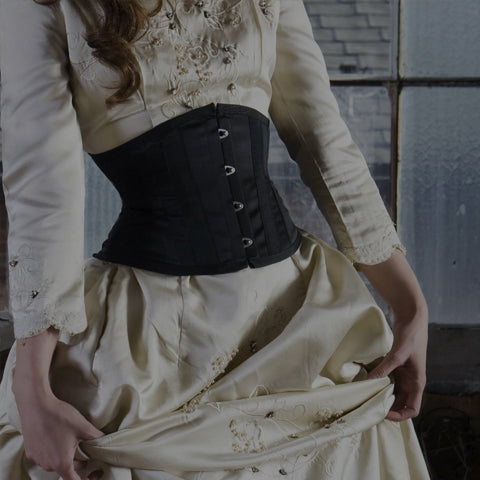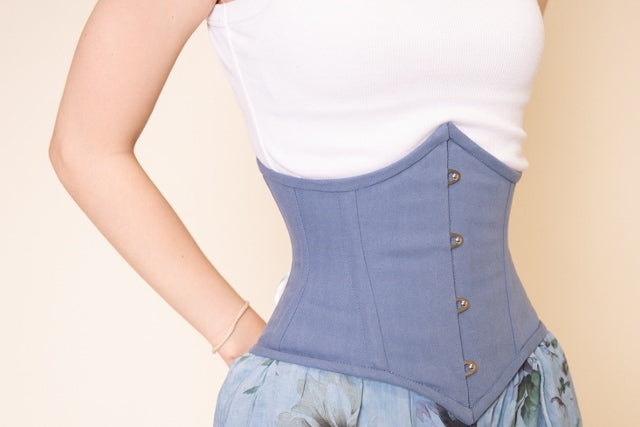Farthingales corset making supplies started carrying a new coutil in May of 2023. It's not, in our opinion, a true coutil. Our herringbone coutil is a true coutil - it's been made by the same company since the early 1800's, specifically for corset making. The new "soft coutil" is a herringbone weave, but it's a looser weave (so it's got a lower thread count). It's got a larger more defined herringbone pattern and it is thicker or loftier - so it doesn't work well for binding the edges (especially not at pointed fronts and backs) as it's just a bit bulky. I love the fabric and think it's a great multipurpose fabric. The looser weave will mean it's not as strong as our traditional coutil, but it's great for a light wear corset and the variety of colours is a nice change.
Make sure to note the shrinkage information on the product page - 100% cotton will shrink, so prewash and dry. Soft Coutil Product Page.
I made a waist cincher with this fabric to try it out. Here are some images and my thoughts.


- I washed and dried the coutil with hot temperatures before cutting it out. This tightened the weave a bit and the fabric felt stronger after doing so. Might have been my imagination :-).
- Cutting the corset out was easy, I lined up the grain lines on the patter with the herringbone weave.
- The pattern I used was a Farthingales downloadable corset pattern
- I admit - I didn't read the instructions and forgot to add seam allowance! The result was a very small corset.
- I used bone casing tape on the seam allowances only and not in the middle of any panels. If you are unsure of how to make a corset check out the Farthingales book section for books on corset making.
- I used two layers of coutil for the front and back panels only and both center back and center front had extra wide seam allowance so that the grommets are securely set through 4 layers of the coutil.
- I used German Plastic boning in all of the bone casings.
- All of this went well. Sewing the curves was easier than it is when using the traditional coutil, which is much stiffer.
- I bound the edges with the coutil, which is what I usually do. This posed a challenge due to the loftiness of this fabric and in order to get the nice sharp points at center front and center back - I finally - after much frustration - made it look good on the outside but not at all nice on the inside!!! In future, I'll use petersham ribbon or bias tape to bind the edges or I'll alter the center front and back to have a more rounded shape.
Overall, I'm happy with the result. I'm not sure it will be a long wearing corset, but you don't always need one to last for years. This is an affordable fabric and I think it would be great from many projects that require a sturdy soft cotton - slouchy pants, aprons, light weight jackets.
It's definitely worth giving it a try. Check out the sample packs that you can order to see the colours and feel the quality. You'll find the swatch packs on the soft coutil product page (use the link above).





Leave a comment
All comments are moderated before being published.
This site is protected by reCAPTCHA and the Google Privacy Policy and Terms of Service apply.